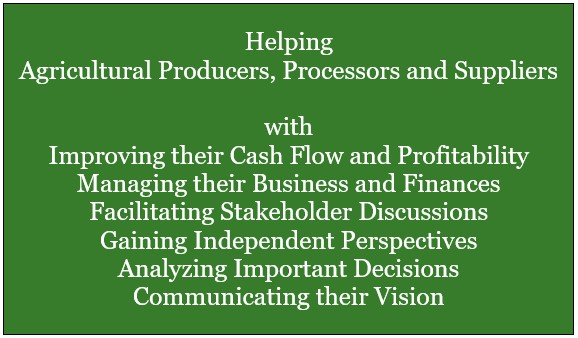If you are using Internet Explorer to view this site, please use another browser for optimal viewing.
Please share this page with these links to Facebook, Twitter, LinkedIn and Email:
Analyzing the many factors contributing to a business’ financial health is much like analyzing the many factors contributing to a person’s overall health.

A doctor may look at a patient’s temperature, weight, blood pressure, heart rate, blood tests, genetics, history, lifestyle, etc. to determine the individual’s overall health condition and the likelihood they may or may not have health issues in the future. Using just one of these items may be an indicator, but it won’t paint the whole picture.
Analyzing the “health” and future prognosis of a business is done much the same way. While some individual factors, like cash flow, may bear more immediate impact, to fully understand the financial health of the business, we need to look at many different factors. This is why we encourage managers to use historical and projected ratios to better assess their historical trends, current financial health and long-term outlook for their business. Understanding the trajectory of a particular ratio and the rate of change is important in determining the impact.

For businesses that are asset-intensive, it’s important to get the most out of those assets, with return on assets (ROA) being a crucial overall ratio to monitor. ROA is a ratio that measures the profits of the business relative to the assets of the business. However, there are many factors that go into both the numerator and denominator of the ROA ratio.
Using other ratios to analyze the performance of a business can help managers determine where they can maximize profitability and minimize the amount of ineffective assets to generate a higher ROA. The other ratios can help identify areas where the business operates well and can be expanded and also areas that may be costing more than is realized in revenue. The following list of ratios are a good start towards understanding some of those factors.
Total Assets per Unit of Production
Total Assets per Unit of Production – How many dollars of assets does it take to produce a unit of production? Keeping this ratio low can lead to a higher return on assets. This ratio can be affected by the amount of outsourcing, leasing and other ways to use assets in the production process without owning them. It can also be affected by the value placed on the assets. Comparing this ratio over time and to other businesses should be done with consistent values to avoid skewing the results.
Total Debts to Total Assets Ratio
Debt to Asset Ratio – How much debt is being used to own the assets? Keeping this ratio low is preferred by lenders to the business and gives the business the ability to grow quickly, pay dividends to the owners and/or withstand losses. However, keeping this ratio higher is preferred by owners who don’t need to invest as much capital to earn the profits of the business. This ratio also needs a consistent valuation of the assets to make comparisons with trends and other businesses more informative.
Current Assets to Current Debts Ratio
Current Ratio – How many assets are available that will convert into cash within the next 12 months (current assets) compared to the debts that are due in the next 12 months (current liabilities)? Keeping this ratio high gives the company liquidity to withstand cash flow adversity and take advantage of opportunities that are presented. However, carrying excess current assets such as cash, receivables and inventories doesn’t contribute greatly to returns and could be risky if they lose value and aren’t collectible.
Cash Flow to Debt Payments Ratio
Debt Coverage Ratio – How much cash flow is being generated from operations compared to the debt payments that are due during the same period? The higher this ratio is, the better the business is doing in meeting its debt obligations. When a business can’t meet its debt obligations with normal cash flow, then they must tap into their liquidity to fund debt payments. Lending institutions put a lot of weight on this ratio as they classify their risk, set interest rate and fee levels and assess the overall attractiveness of the borrower.
Profits per Unit of Production
Profits per Unit of Production – How much profit is being generated on every unit being produced? This ratio is especially helpful when comparing against other producers and comparing against the amount of assets that were utilized to produce each unit. Different business models can skew the results and comparisons usually require further analysis to review the revenue, expense and production drivers that generate the profit for each unit of production.
Profits to Total Revenues Ratio
Operating Profit Margin Ratio – How much operating profit is being earned from every dollar of revenue? Businesses need to maximize revenues and minimize costs to maximize operating profit margins. Managers should think about every cost in their business as an investment just like they would with a large capital expenditure. What return are they getting on each cost they are incurring? Minimizing costs isn’t necessarily the focus. Maximizing profits within the risk appetite of the business should be the focus.
Total Revenues to Total Assets Ratio
Asset Turnover Ratio – How many dollars of revenue are being generated from the assets that are being utilized? In general, businesses want to generate as much revenue from as few assets as possible. Without revenue, businesses can’t create income. Assets must be fully utilized to maximize their revenue potential over the full 12 months of the year. Businesses should sell assets that aren’t fully utilized and use those sale proceeds to invest in assets that can be fully utilized to increase revenue and income.
Profits to Total Assets Ratio – ROA
Return on Assets – How much operating profit is being generated from the assets that are being utilized? Multiplying the Asset Turnover Ratio by the Operating Profit Margin Ratio results in the Return on Assets. While computing these ratios on the entire business can help managers see the overall results, to do a more thorough analysis, each segment of the business should be reviewed for its own impact on the entire business.
Managers can evaluate their business practices by using these ratios to take some of the emotion out of the decision making. This is especially true in cases where “we’ve always done it that way”. Identifying highly productive assets can help managers look for ways to maximize an area where they are doing well. With this information they can improve or capture more profit on productive assets by pinpointing an area the business can use to break away from relying solely on low margin business.
Depending on the type of operation, areas that may have a low asset turnover ratio and low operating profit margin may involve machinery or equipment or buildings that are not as productive. For instance, if managers need to improve their return on assets on machinery, they may look at doing custom work or other services that better utilize the availability of their assets and talents. Or they may sell those assets, hire someone else do that work for them and redeploy that capital into a more productive asset.

Often times many business practices are done based on tradition or routine, rather than financial efficiency. However, we are seeing more businesses taking a closer look at what they do really well and finding ways to create a niche for their business that solves a problem for another business or consumer. Because these types of decisions can have a large impact on the business, it is critical that careful financial analysis is done on each asset prior to making major decisions.
The answer to the best asset to invest in will be different for each business based on their own unique set of circumstances. Uncovering the next layer of profitability based on financial ratios may require the use of a consultant who has the expertise to calculate and evaluate the ratios and help managers make decisions based on the outcomes of the analysis.
How can AgriStrategies LLC help?

